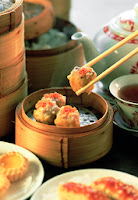 |
| People enjoys dim sum & Chinese tea in tea houses |
Food items that served in tea houses are collectively known as "dim sum", a varied range of small dishes which may constitute or replace breakfast, brunch or afternoon tea. Dishes are usually steamed or fried and may be savoury or sweet. They include steamed buns such as char siu baau, assorted dumplings, siu mai, and rice noodle rolls, which contain a range of ingredients, including beef, chicken, pork, prawns and vegetarian options.
Traditional Tea Houses
 |
| Tea houses were run as the independent restaurant in the past |
At the beginning of tea houses industry, most of the tea houses are run as the independent restaurant, and usually located in the estates, or the business districts; they did not have much items for their customer to choose, and only serving the dim sum traditional dim sum and hot Chinese tea.
 |
| Traditional tea houses were using a la carte menus. |
Besides, as the technology was not developed well in the past, tea houses sold their dim sum by the “dim sum car”, which was controlled by the servers; all the dim sum choices are placed in front of the dim sum car or the wall, and that’s the most initial menu in tea houses. As the “menu” is placed on the dim sum car and wall individually, and all the food items are individually priced, it shows that the traditional tea houses were using a la carte menus in the past.
 |
| Tea houses also used dim sum menu for ordering food in a convenient way |
Except the dim sum car, tea houses also used dim sum menu for customer to order food more conveniently. Unlike the tea houses nowadays, the menu at that time was as like as the menu which placed on wall -- just showing the Chinese name of the food items, their price, and that's it.
On the other hand, the independent tea houses usually design their menus according to the capabilities of cooks, equipment capacity, consistency and availability of menu ingredients, and the price and pricing strategy. It is because there were not many rules that the independent tea houses need to follow in their daily operation; the things that they concern most are their profit and their product quality, and it is the reason why they planned the menus based on their capacity, in order to provide the best quality food to attract and retain their customer.
 |
| One of the outlets of Tao Heung |
 |
| One of the outlets of Super Star Group |
By the early twentieth century onward, tea houses operating as a chain restaurant in Hong Kong are the trend; these groups of tea house can be found everywhere, for example, Tao Heung and Super Star Group. These chain restaurants (tea houses) are using the same name, concept, outlet design, service procedure and standard, and food production in their operation, so that they can enlarge their market share, and enjoy the economic of scale when purchasing the raw materials, hiring the managerial personnel, and promotion, as they own a bigger bargaining power and can divide the fixed cost.
 |
| Tranditional Tea House - Central Luk Yu Tea House |
 |
| New dim sum menu |
For the menu, except the original a la carte menus, as some dim sum set or business lunch set are now provided on the menu, table d'hote menus are also used. Besides, more and more tourist would like to try the traditional dim sum while travelling in Hong Kong, so tea houses tend to use the tourist menu, which provide pictures to attract their attention, or at least understand what the dim sum is.
 |
| Disney theme dim sum - Mike |
 |
| Healthy steamed vegetable dim sum |
References:
http://www.heritagemuseum.gov.hk/chi/exhibitions/exhibition_details.aspx?exid=39
http://nosh.roundmenu.com/wp-content/uploads/2013/01/Chynna-bg-3.jpg
http://www.comp.hkbu.edu.hk/rtcsa2005/pic/food.jpg
http://www.hongkong-purotour.com.tw/img/Food/U139P22T1D86796F1DT20110209112510(1).jpg
http://isanjay.in/wp-content/uploads/2012/02/dimsum_content.jpg
http://www.superstargroup.com.hk/
http://park.hongkongdisneyland.com/hkdl/zh_HK/hotels/latestOverview?name=HotelDiningPage#crystallotus






































.jpeg)
.jpeg)